:: சந்திர உதயம் / மறைவு கணக்கிட
 |
New Moon (Ammavasai) happens when the Moon comes roughly in between
the Sun and the Earth. At this position, we get to see the face of the Moon that is opposite the Sun and hence dark. If this alignment happens perfectly, we get the Solar Eclipse (which is Moon blocking the Sun - partiallly or totally). In this phase, the Moon and the Sun rise and set at about the same time
பூமிக்கும், சூரியனுக்கும் இடையிலே சந்திரன் வருவது அமாவாசையாகும். இந்த கட்டத்தில், சூரியனுக்கு எதிரில் உள்ள சந்திரனின் முகத்தை, நாம் பூமியில் காண்கிறோம். அதனால், அது இருளாக உள்ளது. இவ்வாறு பூமிக்கும், சூரியனுக்கும் இடையிலே சந்திரன் வருவது துல்லியமாக நடைபெற்றால், அது (பகுதி அல்லது முழு) சூரிய கிரகணம் ஆகும். மேலும் இந்த கட்டத்தில், சூரியனும், சந்திரனும் ஏறத்தாழ ஒரே நேரத்தில் உதயமாகி, மறையும். |
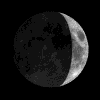 |
Waxing Crescent Moon - As the Moon moves around the Earth, we get to see more and more of the bright half. At first we get to see a slice of it (thin crescent). This grows day by day.
சந்திரன் பூமியை சுற்ற, சுற்ற, சந்திரனின் ஒளியான பகுதிகளை நாம் அதிக, அதிகமாக பார்ப்போம். துவக்கமாக - சிறிய அளவில் (பிறை) காண்போம். நாளுக்கு நாள் அது வளர்ந்து வரும். இந்த கட்டத்திற்கு WAXING CRESCENT MOON என்று பெயர். WAXING என்றால் வளர்ந்து வரும் என்று பொருள். |
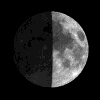 |
First Quarter Moon - About a week after the New Moon, when the Moon has completed about a quarter of its turn around the Earth, we can see half of the brighter side of the Moon.
அமாவாசைக்கு பிறகு, ஒரு வாரம் கழித்து, பூமியை சுற்றி தனது பயணத்தில் கால் பகுதியை (QUARTER) சந்திரன் நிறைவுசெய்திருக்கும். இந்த கட்டத்தில், நாம் - சந்திரனின், ஒளியான பகுதியில் பாதியை காண்போம். |
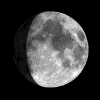 |
Waxing Gibbous Moon - During the following week, we keep seeing more and more of the brighter side of the Moon. It is newdate1 called the Waxing Gibbous Moon(gibbous means "humped")
அதற்கு அடுத்த வாரத்தில், பூமியை சந்திரன் சுற்ற, சுற்ற - சந்திரனின் ஒளியான பகுதிகளை இன்னும் அதிகமாக பார்ப்போம். இந்த கட்டத்திற்கு WAXING GIBBOUS MOON என்று பெயர். GIBBOUS என்றால் தமிழில் கூனல் ஆகும். |
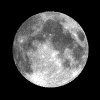 |
Full Moon (Pournami)- About Two weeks after the New Moon, the Moon is newdate1 halfway through its revolution, and newdate1 the bright half of the Moon is totally visible, This is Full Moon. At this position, the Moon rises roughly at the same time the Sun sets, and it roughly sets when the Sun rises. If the Moon happens to align totally or partially with the Earth and Sun, we get a Lunar Eclipse
அமாவாசைக்கு பிறகு, இரு வாரம் கழித்து, பூமியை சுற்றி தனது பயணத்தில் அரை பகுதியை சந்திரன் நிறைவு செய்திருக்கும். இந்த கட்டத்தில், சந்திரனுக்கும், சூரியனுக்கும் நடுவில் பூமி இருக்கும். இப்போது, நாம் - சந்திரனின், ஒளியான பகுதி முழுவதையும் காணலாம். இது பௌர்ணமி காலமாகும். இந்த கட்டத்தில், ஏறத்தாழ - சூரியன் மறையும் போது, சந்திரன் உதயமாகும்; சூரியன் உதயமாகும் போது, சந்திரன் மறையும். இவ்வாறு - சந்திரனுக்கும், சூரியனுக்கும் இடையிலே பூமி வருவது துல்லியமாக நடந்தால், பூமியின் நிழல் சந்திரனில் விழுந்து, (பகுதி அல்லது முழு) சந்திர கிரகணம் ஏற்படும். |
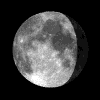 |
Waning Gibbous Moon - From newdate1 on, until it becomes New again, the bright side of the Moon keeps decreasing
பௌர்ணமி கட்டத்தை தொடர்ந்து, அடுத்த அமாவாசை வரை, சந்திரனின் ஒளியான பகுதி சுருங்க துவங்கவிடும். இந்த கட்டத்திற்கு WANNING GIBBOUT MOON என்று பெயர். WANING என்றால் சுருங்கி வருவதாகும். |
 |
Last Quarter Moon - About three weeks after the New Moon, we again can see half of the bright side of the Moon.
அமாவாசையில் இருந்து மூன்று வாரங்கள் கழித்து, சந்திரனின் ஒளியான பகுதியில் பாதியை நாம் காணலாம் |
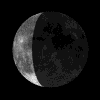 |
Waning Crescent Moon - Finally, after about four weeks, the Moon reduces to a thin size (Crescent) to become a New Moon again
அமாவாசையில் இருந்து ஏறத்தாழ நான்கு வாரங்கள் கழித்து, சந்திரன் சுருங்கி - பிறை வடிவை அடையும். இதன் பிறகு, அடுத்த அமாவாசை ஏற்படும். |

